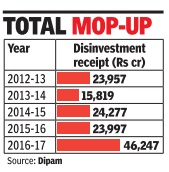Disinvestment: India
This is a collection of articles archived for the excellence of their content. |


Contents |
Year-wise progress
2014-17
Govt tops divestment target, nets over Rs 46k cr, April 1, 2017: The Times of India

The government has managed to scale its budget target for disinvestment and closed the financial year (2016-17) with record receipts of Rs 46,247 crore, compared with the revised estimate of Rs 45,500 crore after it deployed all tools at its disposal.
Although the mop-up is lower than the budget estimate of over Rs 67,000 crore, the shortfall is on account of the Centre's inability to push through strategic sales, including easier options such as ITDC hotels, many of which are to be sold to state governments. It has, however, booked the sale of shares such as L&T, which were held by the Specified Undertaking of the erstwhile Unit Trust of India, as strategic sale which help the government raise Rs 10,779 crore.
But, this is by far a record year for disinvestment, surpassing the 2014-15 level of Rs 24,277 crore. The department of investment and public asset management (Dipam) used all instruments -from initial public offer and follow-on issues to offer for sale via stock exchanges, block deals, exchange traded fund and share buybacks -to raise the funds, which will provide some cushion to the government . If the tax proceeds are in line with the revised estimates, the government may actually end up bettering the fiscal de ficit target of 3.5% of GDP during 2016-17. In any case it has prodded several PSUs, led by oil firms, coal and power sector firms, to cough up special dividend.
This year's disinvestment receipts also include Rs 530 crore from sale of shares to employees of six public sector companies -IndianOil, NTPC, Engineer's India Ltd, NHPC, DCIL and Concor -after the government managed to get Sebi to tweak rules to make the issues more attractive.
The rules allow for allotting 5% of the shares to employees and came with a cap of Rs 2 lakh, which often left shares unsold. The government managed to convince the market regulator to raise the ceiling to Rs 5 lakh. But, the enhanced limit could only be used if shares were unsold after all bidders for up to Rs 2 lakh investment had been exhausted.
IPOs
2003-12 (actual); 2017 (planned)

Fast-Tracking To Help Raise Resources By Unlocking Values
At a meeting in NITI Aayog last December, the idea of pushing state-run firms to list was discussed with the finance ministry and other key stakeholders.It was a reform initiative to make PSUs more accountable and also help the government raise money through disinvestment.
The issue reached Prime Minister Narendra Modi, whose backing to the plan ensured that listing of state-run companies was flagged as a key initiative in the 2017-18 Budget.
Seven months down the line, two public sector initial public offers -Hudco and Cochin Shipyard -have been completed and over the next one year or so, another dozen will hit the markets, said government officers, who see it as a major achievement.
After all, they pointed out that there had been 13 listings over nine years -from 2003-04 to 2011-12. And, there were none for five years, resulting in just over a dozen IPOs over a 14-year period. The fast-tracking of PSU listings will help the government raise resources effortlessly by unlocking the value in these entities.
Along with the 1990 reforms, the government began the process of listing public sector companies. After a rush in the 1990s, there was a pause before the Atal Bihari Vajpayee government unlocked value in several state-owned firms, while others such as Maruti were listed at the time of strategic sale by the Centre.The UPA made a fresh start with listing of companies such as Coal India, but there was a lull since 2011-12.
At the end of August, of the 327 public sector companies (including banks and insurance companies), 53 were listed according to data on the BSE website. They made up 9% of the BSE's market capitalisation and at the end of trading the value of these stocks was estimated at a over Rs 5 lakh crore. Officers said given Sebi's regulations on IPO, the idea is to list only reasonablysized companies.
But it has been an uphill task for the Department of Investment and Public Asset Management (Dipam), especially when several PSUs didn't bother to maintain a proper record of the assets they owned, leave alone having title deeds.Plus, there are other issues related to valuation.
But the biggest challenge has been to get companies in sectors which were reluctant to move to list. For instance, listing of defence PSUs, leave alone disinvestment, was a taboo for “strategic reasons“. Insurance companies were seen as “sensitive“, prompting finance minister Arun Jaitley to list budgeted receipts from the general insurers under a separate head. And, the railway bureaucracy was always reluctant and came up with a proposal to set up a holding company , which was rejected.
“The final listing will depend on the market conditions and the preparedness but we are moving to speed up the process,“ said an official. Indications are that GIC and New India Assurance issues will hit the market over the next few weeks, resulting in the culmination of the reform process in the insurance sector that started 18 years ago with the opening up of the sector to foreign players.
While PSU listings began earlier, the pace is picking up again after a slack. The next challenge will be for the government to get PSUs, including Life Insurance Corporation, holding stocks of other state-run firms to unlock value since they hardly undertake treasury operations.